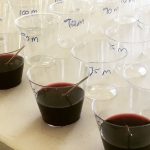Wine Blend Spotlight: Mettler Ranch GSM
A beautiful blend of three Rhone varietals: Grenache, Syrah, Mourvedre. All three of these varietals trace back to the Mediterranean coast and thrive in the Lodi climate. They blend poetically together, each bringing a different flavor profile. Grenache adds a fresh raspberry flavor. The Syrah brings savory dark fruit flavors and a velvety mouth-feel. Mourvedre adds a nice tannin structure and herbaceous aromas. A delicious wine to try!

You can ferment it a number of ways. You can do what is called a “field blend” and blend everything at crush. Or you ferment each varietal seperately. Either way makes a great wine. It all comes down to the equipment you have and the amount of time you have. If you don’t have a lot of storage vessels then doing a field blend is the way to go.
Field Blend Fermentation:
- Crushing and Fermenting: After harvesting, co-ferment the grapes together in the same fermentation vessel. This means that the Grenache, Syrah, and Mourvèdre grapes are all mixed together from the start. The co-fermentation process allows for the blending of flavors and characteristics at the earliest stage.
- Temperature Control: Control the fermentation temperature carefully, as each grape variety may have different requirements. Find a temperature that works well for all three varieties to ensure proper extraction of flavors and tannins.
- Taste and Adjust: Monitor the fermentation process and taste the wine to assess the development of flavors. Make any necessary adjustments, such as adding yeast or adjusting the temperature, to achieve the desired characteristics.
- Aging: After fermentation, age the wine in suitable containers, such as oak barrels or stainless steel tanks. Aging allows the flavors to meld and develop complexity.
- Bottling: Once the wine has aged to your satisfaction, bottle it. Label the bottles with the vintage and the type of field blend GSM.
- Enjoy: Once the wine has aged to your satisfaction, bottle it. Label the bottles with the vintage and the type of field blend GSM.
Creating a field blend GSM wine is a unique approach that requires careful planning and execution in the vineyard. It can result in a wine with distinctive characteristics that reflect the terroir and the synergy of the three grape varieties grown together.
Fermenting the Grapes Seperately:
- Fermentation: Fermenting each grape variety separately helps control the extraction and balance of flavors. Add yeast to start the fermentation process. Pro Tip: Use different yeasts for each batch and you will create even more complexity!
- Temperature: Monitor and control the fermentation temperature. Grenache, for example, generally benefits from higher fermentation temperatures, while Syrah and Mourvèdre might require lower temperatures to preserve their desired characteristics.
- Taste and Analyze: Taste the wines from each varietal to understand their individual characteristics. Analyze factors such as aroma, flavor, acidity, tannin, and alcohol content.
- Blending Trials: Once each wine has completed fermentation and has been aged to your liking, start experimenting with different blends. This is where the art of blending comes into play. Start with small trial blends and make adjustments to the ratios until you achieve the desired flavor profile and balance.
- Age the Blend: Blend the wines together and allow the blend to age in a suitable container, such as oak barrels or stainless steel tanks. The aging process helps the different components integrate and develop complex flavors. *For more information on againg your wines, check out this blog post
- Regular Tasting: Blend the wines together and allow the blend to age. The aging process helps the different components integrate and develop complex flavors.
- Bottle: Once you’re satisfied with the blend and the wine has aged to your liking, bottle it. Make sure to label the bottles appropriately, indicating the vintage and the blend.
- Enjoy: Allow the bottled wine to rest for a period before opening and enjoying. GSM blends often benefit from some additional bottle aging to reach their full potential.
GSM blends are known for their bold, rich, and complex flavor profiles, often characterized by red fruit, spice, and earthy notes. The proportions of each grape variety in the blend can vary, but Grenache is typically the dominant grape, with Syrah adding structure and Mourvèdre contributing depth and complexity. Experiment with different proportions to create your own unique GSM wine blend.
The Mettler Ranch wine grapes are available for purchase every Fall Season. If you are interested in the Mettler grapes we suggest making a pre-order by mid-August. For more information on the Mettler Ranch click here.
We’re here to help when you need it
Musto Wine Grape offers a variety of products as well as services including testing and support. Email sales@juicegrape.com or call (877) 812 – 1137 to speak with someone who can assist you.
Top 7 Winemaker Resolutions
It’s that time again! Where you start to reflect on the past year, look forward to a fresh start, and set forth some new year’s resolutions. But resolutions don’t just apply to weight loss and self improvement, they can also apply to winemaking. According to the Merriam-Webbster Dictoinary a resolution is defined as “to make a definite and serious decision to do something“. So what do we want to decide and do, when it comes to our winemaking? What can we do to elevate our winemaking? Or better yet, make the type of wine we love drink to and share.
We’ve come up with a few resolutions for the winemaking year ahead. Many of them come from our own mistakes during the winemaking process, tips and tricks we’ve learned along the way, and some of it is super fun.
7 Suggested Resolutions for Winemakers in 2022
Be more detailed when recording winemaking notes.
You know how it is. You’re exhausted from crush day. You’re covered in must, sticky, maybe a little tipsy from enjoynig last year’s wine while crushing (we all do it, and love it ;)), and the last thing you want to do is record your starting must numbers. No matter which way you slice it, detailed winemaking records aid us in creating wines without flaws, keep us on track, and help us create our favortie wines. Need help with record keeping? Email cmusto@juicegrape.com for an example.
Have that blending party.
Wine blending can be meticulous for some, but really, it’s a great excuse to get togther and enjoy the fruits of your labor. Blending wines is one of the best ways to tweak your wine to make it even more delcious than the year before. There’s a great free video you can watch on WinemakingInstructions.com for inspiration as to how to throw a wine blending party.
Visit the grapes….FINALLY
That’s right I said it, it’s time to go see the grapes. If you haven’t been out to visit Lanza-Musto Vineyards it’s time. It’s finally safe to travel again and Suisun Valley is right next to Napa. So it’s part research, part vacation, or maybe it’s just all vacation. Either way you’re in California, enjoying wine country. Who wouldn’t want to do that? If you’re interested in visiting Lanza-Musto Vineyards email cmusto@juicegrape.com to learn how you can set up your vineyard visit. Musto Wine Grape is very transparent about who we source from and are happy to introduce you to our growers.
Read that wine book
Who doesn’t have a wine book laying around that they have been meaning to read? I know I have at least three. My list includes Daniel Pambianchi’s newest book – Modern Home Winemaking, The Academie Du Vin Wine Cellar Book by Steven Spurrier, and I Taste Red by Jamie Goode. A second part to this resolution is to take notes on each book. Kind of like a book report you did back in school. Nerdy I know, but it helps me retain the information better. Plus I have a feeling I’ll be refering back to all of these texts. Which books are on your list? Suggestions are welcomed, feel free to email me -cmusto@juicegrape.com.
Visit more local wineries, breweries, distilleries, and cideries
Inspiration can come from anywhere. Many wineries were inspired by distilleries and the flavor profiles they produced with thier bourbons, igniting the bourbon barrel aged wine trend. And who doesn’t like supporting local? Plus getting to know your local fermentors can help if you ever have questions or need help with your fermentations. Plus it’s always a ton of fun. So get tasting!
Clean that wine room
You knew I was going to bring this up. Clean, sanitize, repeat. It is one of the best ways to ensure your wine turns out the way you want it. Cleanliness is key and my cellar needs some sprucing. How about yours? Here is a great blog post with best practices.
Plan out your winemaking year
Perfect the process. Every year harvest sneaks up on us, yet we know when it will happen every year. Put a reminder in your phone and on your calendar for the start of the Spring and Fall seasons. South African grapes/juices usually arrive around late March, Chileans late April / early May, California starts in early September, and Washington State starts in October. Think about what you want to make (new varieties to try?), your fermentation protocols (any new yeasts you want to try?), your fermentation and aging vessels (should I spring for the stainless?), and how much wine you need to get bottled before they all arrive. Plus if you plan ahead you’ll have more time for blending parties, bottling parties, and good old fashioned friend get togethers where you share your wine.
We hope you enjoyed some of our resoultion tips and look forward to seeing you all in the new year. Cheers to 2022 Winemakers!








Recent Comments